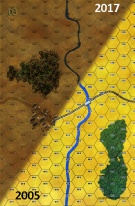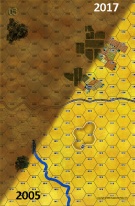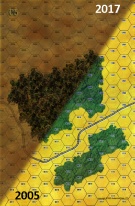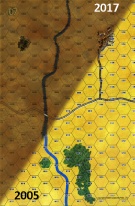|
The Christmas Battle: Right Flank Fronte Russo #17 |
||
|---|---|---|
|
(Defender)
Germany
(Defender) Italy |
vs | Soviet Union (Attacker) |
| Formations Involved | ||
|---|---|---|
| Germany |  |
213th Security Division |
| Germany |  |
318th Infantry Regiment |
| Italy |  |
2ª Compagnia Motociclisti Bersaglieri |
| Italy |  |
47º Battaglione Motociclisti Bersaglieri |
| Italy |  |
XX Battaglione Bersaglieri |
| Italy |  |
XXV Battaglione Bersaglieri |
| Soviet Union |  |
63rd Guards Rifle Division |
| Soviet Union |  |
68th Cavalry Division |

|
| Overall Rating, 3 votes |
|---|
|
3.67
|
| Scenario Rank: --- of 940 |
| Parent Game | Fronte Russo |
|---|---|
| Historicity | Historical |
| Date | 1941-12-25 |
| Start Time | 08:30 |
| Turn Count | 30 |
| Visibility | Day |
| Counters | 167 |
| Net Morale | 0 |
| Net Initiative | 0 |
| Maps | 8: 1, 15, 18, 3, 4, 5, 6, 7 |
| Layout Dimensions | 112 x 86 cm 44 x 34 in |
| Play Bounty | 195 |
| AAR Bounty | 171 |
| Total Plays | 2 |
| Total AARs | 1 |
| Battle Types |
|---|
| Exit the Battle Area |
| Urban Assault |
| Conditions |
|---|
| Entrenchments |
| Off-board Artillery |
| Reinforcements |
| Severe Weather |
| Terrain Mods |
| Scenario Requirements & Playability | |
|---|---|
| Eastern Front | Maps + Counters |
| Fronte Russo | Base Game |
| Road to Berlin | Maps + Counters |
| Introduction |
|---|
|
On Celere Division's extreme right (where its lines met those of the German 198th Infantry Division), the village of Petropavlovka was defended by Celere's motorcycle battalion (which had lost its motocycles and now fought on foot), and the village of Rassypnaia was held by the XXV Bersaglieri Battalion. The XX Battalion was stationed to the rear as a sector reserve in Stohskoff. The Soviet attack here was carried out by the 541st Regiment of the 136th Rifle Division, supported by elements of the 68th Cavalry Division. |
| Conclusion |
|---|
|
At approximately 1100, the defenders were forced to give up and retreat to Rassypnaia (on Board 4), where the XXV Battalion held firm. In the meantime, the Soviets had invested Stohskoff (on Board 1), and Cossack cavalry had moved as far as the divisional HQ at Katik (off the south edge of Board 6), defended only by anti-aircraft units and mixed staff troops. The latter attack was repulsed thanks to intense AA fire and steadiness shown by the assorted defenders. The situation in Stohskoff was becoming critical when relief came from the just-released 3rd Battalion of the German 318th Regiment. |
| AFV Rules Pertaining to this Scenario's Order of Battle |
|---|
|
| 4 Errata Items | |
|---|---|

|
The reduced direct fire value of the Heer HMG became 5-5 starting with Fall of France. (plloyd1010
on 2015 Jul 31)
|

|
All SPW 251s have an armor value of 0. (Shad
on 2010 Dec 15)
|

|
The reduced direct fire value in Kursk: Burning Tigers is 4-4. (plloyd1010
on 2015 Jul 31)
|

|
Kommissars never get morale or combat modifiers. Ignore misprints. (Shad
on 2010 Dec 15)
|
| Somewhat Noisy off to the north | ||||||||||||||
|---|---|---|---|---|---|---|---|---|---|---|---|---|---|---|
In this, the third of the Christmas battle scenarios that Daniel and I played, the Italians set up with a battalion in each of three separate towns. Each town has entrenchments scattered about to aid in interdicting an advancing force. The Soviets come in regimental size with additional cavalry and will hit one of these Italian held towns almost immediately, well before any aid can be provided from any other Italian forces. Experience in the other two Christmas battles indicated that it is imperative for the Italians to stay under cover. The Soviets are blessed with mountains of artillery and it is important to use the towns and entrenchments as a way to avoid the worst effects of that, while keeping the Soviets subject to the Italian artillery, which in this scenario is quite powerful. As a result, the garrison of the front line town (Petropavlovka) was left to live or die on its own. Artillery would have to serve as the killing machine and the garrisons of the other two towns would only appear if it appeared that there was something to gain from the incursion. The victory conditions are quite stark. The Soviets have to capture the garrisoned towns, exit a battalion and kill Italians. The Italians can alleviate some of the Soviet gains by killing Soviets. The end result became apparent relatively early on as the Soviet losses mounted, ultimately reaching 24 steps while the Italians only lost 11. The difficulty was the inability of the Soviets to shake the defenders. While my Italians did try some more aggressive movements (a leader moved into spotting position and was turned into paste by the Soviet artillery and a similar result awaited a platoon that sallied forth from one of the other towns to support the defenders of Petropavolovka), they were primarily happy to spot for the artillery and prior to being invested, fire opportunity fire). The high morale meant that they were relatively unscathed by the assaulting Soviets who, time and time again failed to register step losses in their attacks. In the end, while nearly half of the garrison of Petropavlovka had fallen they remained to contest the town and spot for the artillery. In a rather gruesome event, the Soviet Kommisar managed to kill off nearly as many Soviet steps as the attackers were able to kill in Petropavlovka, greatly aiding my Italians march to the 20 steps necessary to reduce the Soviet victory levels. In the end, Daniel's poor dice and my very positive dice resulted in a Major Victory for the Italians, a consistent result throughout the entire Christmas battle series. We believe, however, that the best result likely for the Soviets in a reasonable battle would be an Italian Minor Victory. Daniel did get his cavalry off the board to win one victory condition and if he had been able to take the town he might also have eliminated enough Italian steps to reach 3 objectives but it would be highly likely to have cost him the 20 steps losses which would give the Italians a minor victory. We played with the fourth edition but feel that this one is eminently playable in either version. In addition, the scripted nature of the play makes it well suited for solo play although we obviously played it through as a ftf endevour. I give it a "3" and feel that such a rating is possibly generous. In saying that, I don't mean that it isn't a great simulation of the battle but that the battle itself is a grim one. The Soviets must attack and will die and the Italians really should not sally forth meaning that the battle will revolve around control of a very few hexes and will be decided by morale checks. As a parenthetical note the southern boards (6 and 18) are very unlikely to see any action other than Soviets who are attempting to exit the board (most likely the cavalry) moving through. It the setup of 8 boards is too large for your space you can drop those two boards and require the Soviets to exit the board prior to the end of the scenario. |
||||||||||||||
| 0 Comments |

 FrRu016
FrRu016 











































